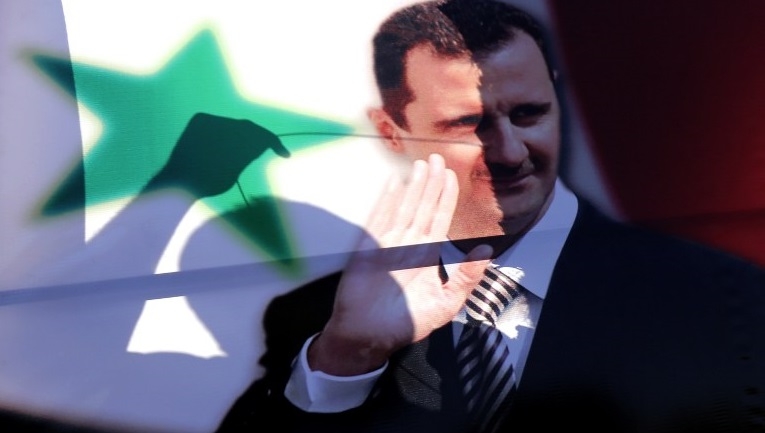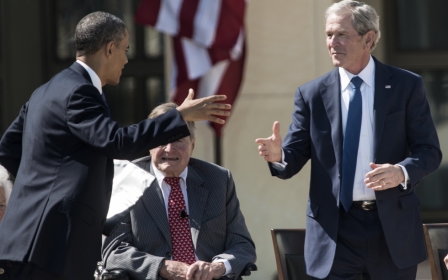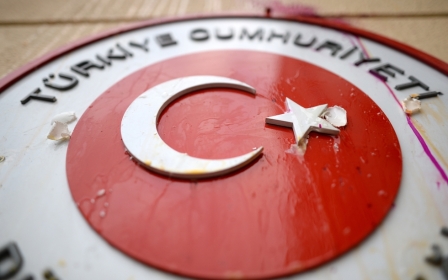
How Western academics help spread Assad's propaganda
From the beginning of Syria's war, the regime of Bashar al-Assad, enabled by Iran and Russia, has run a very elaborate media war to portray itself as the victim of an international conspiracy, wherein its only opponents are terrorists from al-Qaeda and its offshoots who are being used by foreigners - namely the Gulf States, Turkey, Israel, and the United States - to overthrow a defiant "resistance" state.
The other part of this strategic messaging is aimed at the West, which Assad otherwise accuses of supporting jihadi-Salafist terrorism against him: Assad is the only alternative to the terrorists, it says, so the West should support him. War criminal he might be, he will protect the minorities - his role in endangering them by starting a sectarian war against the Sunni majority and bolstering the takfiris within the insurgency to cannibalise all legitimate or engageable armed opposition, notwithstanding - and has no immediate plans to fly planes into Western skyscrapers. (That the leading edge of Assad's ground forces are made up of radically sectarian, foreign Shia jihadists under Iran's control, some of them Iraqis responsible for killing a quarter of the 4,000 US soldiers who fell in Mesopotamia, and are integrated into a state-run terrorist network that has struck Western and Jewish targets the world over, gets left out.)
For Assad and his allies, it helps if this propaganda is not only delivered by regime spokesman but independent analysts, journalists, academics, and politicians. In the last 10 days two salient examples have emerged: Stephen Kinzer, a veteran journalist, including for The New York Times, who wrote in The Boston Globe, and Jeffrey Sachs, an academic economist working at Columbia University, who wrote in The Huffington Post. Mixing together conspiracy theories, half-truths, and outright lies - disinformation, to give it an old name - both Kinzer and Sachs told a version of the regime's narrative. Why they did this is best-known to them.
A matter of framing
A central point of misinformation in both Sachs' and Kinzer's articles is that the US is hell-bent on overthrowing Assad. When Syria's uprising broke out, "the CIA and the anti-Iran front of Israel, Saudi Arabia, and Turkey saw an opportunity to topple Assad quickly and thereby to gain a geopolitical victory," Sachs writes. Note the list of states that Sachs cites as being ranged against Assad. In many ways, it has to be said, Sachs can be forgiven for thinking this. In 2011 and since, those interested in containing Iran were advocating the Assad regime's overthrow: Iran's gateway into the Arab world, its lifeline to the terrorist Hezbollah in Lebanon, and increasingly an Iranian vassal regime on NATO's doorstep. But in reality, US policy has been essentially the exact opposite.
While President Obama said Assad must "step aside" in August 2011 and drew a "red line" around chemical weapons of mass destruction in August and December 2012, he never had any intention of enforcing either; the overarching goal was to stay out of Syria. In December 2011, Obama told Nouri al-Maliki, Iraq's then-prime minister whose relationship with Iranian intelligence goes back decades, "We have no intention to intervene militarily" in Syria. The regime's propaganda campaign basically worked. The US was expressing misgivings about the Syrian rebellion in terms reminiscent of regime talking points by early 2012 and shortly thereafter Assad's survival became part of a broader US policy realignment.
Barack Obama came into office determined to reduce the US footprint in the Middle East, where the US was "over-invested," as Obama's former national security adviser Thomas Donilon put it, and the president alighted on détente with Iran as the means of achieving this.
By respecting Iranian "equities" in the region and finding areas of common interest - such as fighting the Islamic State (even if such common interests are illusory) - Obama hoped to create an "equilibrium" that could police itself with minimal US involvement. The nuclear deal would facilitate rapprochement, removing a thorny issue from US-Iranian relations and giving Tehran access to resources to pursue these overlapping interests.
This was a fantasy, of course. But it did have practical implications. Iran has the Quds Force and other asymmetric instruments that mean any attempt to "balance" between Iran and its neighbours favours Iran. Iran saw US reduced investment in the region as a chance to establish its own hegemony, and with Russia's help it is well on the way. Since the paper agreement was the thing the US wanted - rather than to verifiably disarm Iran - it meant that the leverage in the nuclear negotiations themselves was tilted toward Iran; it also meant Iran could extract concessions in the region with the implicit threat that it would walk away from the table if it didn't get them.
To preserve the nuclear deal and Obama's concept of a new regional order, Syria was given to Iran as a sphere of influence. Iran was informed ahead of time when the US began airstrikes against IS, for example, and told Assad would not be a target - granting Assad a de facto US security guarantee. Iran made sure of that by turning US troops in Iraq into hostages - giving the administration a rationalisation for not upsetting Tehran in Syria.
So the whole framing of the articles is wrong. But that can be ascribed to bad analysis; an over-reliance on the public statements and messaging of the Obama administration, rather than a focus on its actions. Other parts of the articles are not susceptible to so innocent an explanation.
Assad as saviour
Within a month of Russia's intervention, 35,000 people had been displaced from just two villages in Aleppo and 120,000 or more in total had been displaced either directly by Russia's air strikes or by Russian air power enabling offensives by pro-regime forces - usually led by Iranian-controlled foreign troops. Within days of Russia enabling the pro-regime ground forces to cut the last supply line from Turkey to the rebellion in eastern Aleppo City on 3 February, anything up to 70,000 civilians fled fearing the imposition of starvation-sieges the regime has in place in forty-nine other locations. Many of the remaining civilians in Aleppo City are trapped for one reason or another such as they are already displaced and don't have the resources to move again or are elderly. This was a fairly decisive case of people voting with their feet.
Russia has directly committed "egregious" war crimes, according to Amnesty International, deliberately targeting civilians and then following up with attacks on first-responders in an unmerciful campaign intended to terrorize the population into submission. These "double-tap" atrocities, against groups like the Syrian Civil Defence ("The White Helmets") that have saved tens of thousands of lives, have been repeatedly documented. Russia has also systematically targeted civilian infrastructure like hospitals and schools. Subtlety not being Moscow's leading skill, it wasn't just a hospital but a hospital for children injured and disabled by its own bombing raids that Russia flattened last Monday.
Meanwhile, the Assad regime, enabled at every stage by Iran and Russia, not only bears moral responsibility for every death in this war since it met peaceful protests with live fire and turned a struggle for its spoils system into a grand religious war, but has gone some way to distinguish itself - above and beyond even the Islamic State - for the scale of its cruelty and murder. Six-hundred witnesses and a mountain of documentation taken out of Syria led the United Nations to conclude that the regime was guilty of extermination, rape, and five other crimes against humanity, as well as a raft of war crimes.
The liquidation of at least 11,000 prisoners held by the regime using torture and starvation has been revealed by the defector Caesar. Something like 200,000 more are held in regime detention in subhuman conditions. In November 2011, barely a month after organised armed resistance had broken out, the UN reported that among the tactics the regime was using to suppress the uprising was raping male children in front of their families. Later the regime would cause female captives to bleed to death by inserting rats into their vaginas.
IS burned a pilot alive in a cage; the Iranian-run sectarian militia, the National Defence Force, which has eclipsed the national army, burns whole families alive in their homes. And that is before the regime's methods of warfare - indiscriminate artillery fire, barrel bombs, and air strikes to destroy ancient cities, and chemical weapons of mass destruction and chlorine-laced incendiaries to intimidate - aimed at mass-killing and the displacement of survivors is factored in.
This isn't esoteric knowledge, which means there is no excuse for Kinzer to write, referring to Assad possibly reconquering Aleppo City: "This month, people in Aleppo have finally seen glimmers of hope." Nor is there an excuse for Sachs to write - as Russia uses all talk of a ceasefire to cover for its advancing frontlines in Aleppo, gains from aggression it hopes to have the international community recognise - that "The US policy under [Secretary of State between January 2009 and January 2013 Hillary] Clinton and until recently - has been: regime change first, ceasefire after."
Shifting the blame
Since both Sachs and Kinzer present a universe in which Assad is victim rather than perpetrator of the Syrian catastrophe, however, the corollary is to assign blame elsewhere. In line with regime propaganda, this burden falls overwhelmingly on the United States.
To press this argument of Assad as the wronged party, Sachs blames the US for the breakdown of the April 2012 ceasefire. "[Kofi] Annan's peace efforts were sunk by the United States' unbending insistence that US-led regime change must precede or at least accompany a ceasefire," Sachs writes. Kinzer says the same thing: "In 2012 Secretary of State Clinton joined Turkey, Saudi Arabia, and Israel in a successful effort to kill Kofi Annan's UN peace plan because it would have accommodated Iran and kept Assad in power, at least temporarily." But it isn't true.
The US urged the Syrian opposition not to use violence long after it became obvious that they either had to defend themselves with force or suffer death and worse along with their families. The attempted ceasefire in January 2012 was shattered when Assad shelled Zabadani to rubble, and the 4 April ceasefire - which never really took hold - was decisively broken when Assad committed a deliberately sectarian massacre in Houla on 25 May, murdering more than 100 civilians.
It is also necessary for Sachs and Kinzer to defame the rebels. The rebellion was a "CIA-led insurgency," says Sachs, where "the mercenaries sent in to overthrow [Assad] were themselves radical jihadists". "If the truth were fully known, the multiple scandals involved would surely rival Watergate in shaking the foundations of the US establishment," Sachs writes, without offering a shred of evidence. Kinzer refers to the rebels as "violent militants" whose takeover of Aleppo "began with a wave of repression".
Both Sachs and Kinzer also accuse the Western media of covering up what has really happened in Syria. "Where is the establishment media in this debacle?" Sachs asks rhetorically. "Much of the American press is reporting the opposite of what is actually happening," writes Kinzer. While Kinzer lauds the "astonishingly brave correspondents in the war zone," he says that "their voices are lost in the cacophony …[,] overwhelmed by the Washington consensus," which is taking its instructions from "the power elite and its inbred mendacity."
That Kinzer has not himself reported from Syria need not have damaged his case, but his attempt to ventriloquise those who have when they so obviously oppose his point of view does seriously undermine Kinzer's argument. Marie Colvin, Austin Tice, James Foley, Sam Dagher, Mike Giglio, Rania Abouzeid, David Enders - it's hard to think of anybody who has been inside Syria who supports the regime's narrative as peddled by Sachs and Kinzer.
Lies and delusion
The articles also distinguished themselves by the inclusion of material that in Kinzer's case it is hard not to conclude is indicative of an agenda, and while Sachs appears to share that agenda he also seems to be addled with conspiracy theories of a very traditional kind.
Kinzer writes that "we have almost no real information about the combatants". Again, it just isn't true. The US's ex-ambassador in Syria explained in mid-2014 that the US had known who the rebels were "for years". Others - myself included - have tried to give more granular detail on not only the composition of the insurgency by numbers but its ideological distinctions and the connections between various groups.
Kinzer allegedly quotes an Aleppine saying that "only" Assad and his "allies" "are fighting ISIS," a flat-out lie. As adumbrated above the regime has largely left IS alone (as has Russia) and focused on eliminating the nationalist rebels, who actually have been fighting IS. Kinzer also conveniently leaves out the fact that these "allies" are Iranian-run sectarian jihadists - including three listed terrorist organisations: the Quds Force, Lebanese Hezbollah, and Kataib Hezbollah.
In his most dense (in every respect) paragraph, Kinzer says:
Washington-based reporters tell us that one potent force in Syria, al-Nusra, is made up of "rebels" or "moderates," not that it is the local al-Qaeda franchise. Saudi Arabia is portrayed as aiding freedom fighters when in fact it is a prime sponsor of ISIS. Turkey has for years been running a "rat line" for foreign fighters wanting to join terror groups in Syria, but because the United States wants to stay on Turkey's good side, we hear little about it. Nor are we often reminded that although we want to support the secular and battle-hardened Kurds, Turkey wants to kill them. Everything Russia and Iran do in Syria is described as negative and destabilising, simply because it is they who are doing it - and because that is the official line in Washington.
It is tempting to adapt Mary McCarthy's famous remark about Lillian Hellman and say every word Kinzer writes here is a lie, including "and" and "the".
Nobody has ever denied that Jabhat al-Nusra is al-Qaeda's Syrian branch. Turkey's role as an open door for jihadi-Salafists at times in this war has been widely reported, and the clashes with the Kurdish PKK has been headline news for weeks - and nor has Turkey been portrayed favourably in most of the coverage.
The myth of Saudi Arabia as a financier of IS apparently will not die but it simply isn't true. IS deliberately chose to eschew the al-Qaeda model of relying on external donors: since 2005 - i.e. even during its nadir - no more than five percent of IS's funding ever came from foreign individuals and none of it ever came from the Saudi government. If Kinzer wanted to look at IS's sources of funding, its shared hydrocarbon industry with the Assad regime - assisted by Kremlin-approved oligarchs and technicians - might be a better place to start.
Sachs concludes on a rather different note:
It takes great presidential leadership to resist CIA misadventures. … Many historians believe that JFK was assassinated as a result of his peace overtures to the Soviet Union, overture he made against the objections of hardline rightwing opposition in the CIA and other parts of the US government.
"Many" historians don't believe JFK was assassinated by "hardline" elements of the US government. Sachs believes that, evidently - he has written a book about it. Oliver Stone believes that. But "many" serious people do not for the simple reason that, when examined for even a second, President Kennedy's record as a Cold Warrior is crystal clear.
Conclusion
Syria has suffered deficiencies in reporting. The joint effort by Assad and IS to present Syria as a binary choice between themselves has led to a terrible campaign against independent media that can contradict them. When Assad pulled back from northern Syria in the summer of 2012 and then-secret IS agents began filling some of the void, one of the first things they did was start kidnapping journalists, making it so dangerous for journalists in Syria that the regime (and Iran and Russia) and IS had almost a monopoly over coverage. (The rebellion was too busy fighting a three-sided war with the regime, IS, and the PKK to put together much of a media infrastructure.)
But Sachs and Kinzer were not even an attempt to correct for these problems. Theirs was an indefensible attempt, much more in the tradition of Walter Duranty rather than the brave journalists reporting at present from Syria whom Kinzer tries to annex, to whitewash a mass-murderer and his enablers.
-Kyle Orton is a Middle East analyst and an associate fellow at the Henry Jackson Society. This article was first published in Kyle's blog.
The views expressed in this article belong to the author and do not necessarily reflect the editorial policy of Middle East Eye.
Photo: A portrait of Syrian President Bashar al-Assad in Damascus on 11 May, 2014 (AFP).
New MEE newsletter: Jerusalem Dispatch
Sign up to get the latest insights and analysis on Israel-Palestine, alongside Turkey Unpacked and other MEE newsletters
Middle East Eye delivers independent and unrivalled coverage and analysis of the Middle East, North Africa and beyond. To learn more about republishing this content and the associated fees, please fill out this form. More about MEE can be found here.




